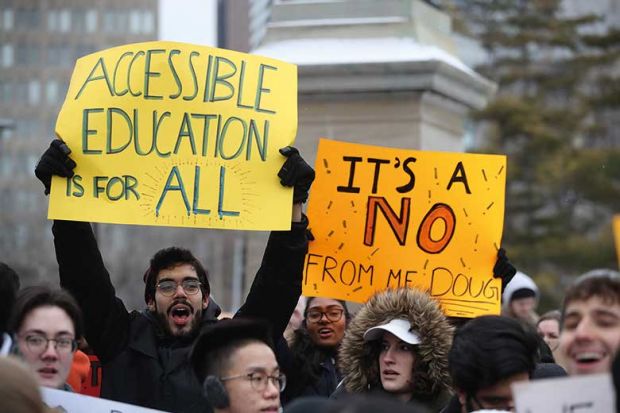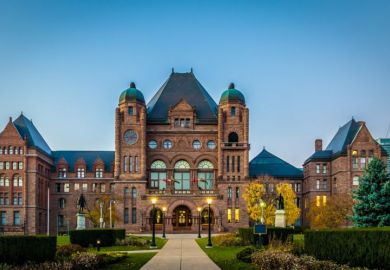Students in Canada’s largest province have protested against a move by the Ontario government that both hikes costs for students and lowers revenues for their universities – but institutions themselves appear to be quietly accepting it.
The divergence in responses appears to be tied in large part to the fact that the universities and their leaders sit far better positioned than the students to cope, given Canada’s foreign recruitment boom.
“Most of [Ontario’s universities] will be able to make up much of that with increased international student enrolment,” said Alex Usher, a Toronto-based higher education consultant. “And that is the way most of them are going to deal with it.”
Students, on the other hand, have taken to the streets after Doug Ford, Ontario’s premier, announced that while tuition fees for domestic students would be reduced by 10 per cent, government aid for those students would be cut even deeper.
The pain will be felt most by Ontario’s lowest-income students, as the Ford administration policy includes ending free tuition. In total, the aid cuts value C$600 million (£344 million), while universities will not be reimbursed for the C$440 million reduction in fee revenue.
Both the aid cuts and the change in fee structures were points of protest at several demonstrations across Ontario. Many participants accused the Ford administration of failing to understand the seriousness of the financial challenges that they face.
Some said that a change to exempt students from paying fees that were established through student referendums and which go towards support activities would hit scholarship and employment programmes, on-campus food banks, and academic appeals services.
But Ontario’s universities minister, Merrilee Fullerton, told CBC Radio that the Ford administration wanted to give students more choice over fees that may have been decided before they arrived on campus.
Dr Fullerton said that the administration cut the student aid programme to make it more sustainable. Free tuition, in particular, was being distributed without any corresponding requirement for academic success, she said.
Leaders of Ontario’s top universities declined to comment on the matter. Spokesmen for two of them said that it was too early for their institutions to assess the full effects of the cuts in their tuition income.
Their silence, said Mr Usher, the president of Higher Education Strategy Associates, largely reflected the fact that, for the most part, “the institutions got off lightly and it’s the students who got hit harder”.
The universities, he said, recognised that the Ford administration was elected last year with a promise to balance the provincial budget and to make every department absorb its share.
“That’s pretty much what’s happened here,” Mr Usher said. “Nobody likes a cut, but 3-4 per cent, from where they are, is not exactly the end of the world.”
And to the degree that colleges might want to protest somewhat on behalf of their students, Mr Usher said, they are muted by their recognition of Mr Ford’s reputation for being politically vindictive.
“They’re quiet because they’ve got to live with this government for four years,” he said, “and they don't want to get into a fight with him early on.”
Mr Ford has already attracted controversy since his election last June by demanding that universities implement and comply with a campus free speech policy that meets a minimum government standard.
Register to continue
Why register?
- Registration is free and only takes a moment
- Once registered, you can read 3 articles a month
- Sign up for our newsletter
Subscribe
Or subscribe for unlimited access to:
- Unlimited access to news, views, insights & reviews
- Digital editions
- Digital access to THE’s university and college rankings analysis
Already registered or a current subscriber?







